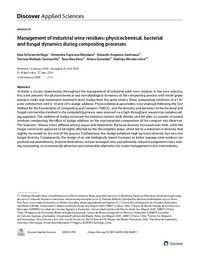Mostrar el registro sencillo de la publicación
Management of industrial wine residues: physicochemical, bacterial and fungal dynamics during composting processes
| dc.contributor.author | Echeverría-Vega, Alex | |
| dc.contributor.author | Espinoza-Mondaca, Almendra | |
| dc.contributor.author | Arqueros-Sanhueza, Eduardo | |
| dc.contributor.author | Mellado-Quintanilla, Denisse | |
| dc.contributor.author | Roa-Roco, Rosa | |
| dc.contributor.author | González, Alvaro | |
| dc.contributor.author | Morales-Vera, Rodrigo | |
| dc.date.accessioned | 2024-08-07T15:11:22Z | |
| dc.date.available | 2024-08-07T15:11:22Z | |
| dc.date.issued | 2024 | |
| dc.identifier.uri | http://repositorio.ucm.cl/handle/ucm/5593 | |
| dc.description.abstract | To foster a circular bioeconomy throughout the management of industrial solid wine residues in the wine industry, this work presents the physicochemical and microbiological dynamics of the composting process with white grape pomace, stalks and wastewater treatment plant sludge from the same winery. Three composting windrows of 41 m3 were constructed with 0, 10 and 20% sludge addition. Physicochemical parameters were assessed following the Test Method for the Examination of Composting and Compost (TMECC), and the diversity and dynamics of the bacterial and fungal communities involved in the composting process were assessed via a high-throughput sequencing metabarcoding approach. The addition of sludge increased the moisture content, bulk density, and pH after six months of turned windrow composting. No effect of sludge addition on the macronutrient composition of the compost was observed. The Shannon‒Wiener index differed among stages and treatments. Bacterial diversity increased over time, while the fungal community appeared to be highly affected by the thermophilic stage, which led to a reduction in diversity that slightly recovered by the end of the process. Furthermore, the sludge exhibited high bacterial diversity but very low fungal diversity. Consequently, the design of on-site biologically based strategies to better manage wine residues can produce soil amendments, improve fertilization, reclaim damaged soils, and ultimately reduce management costs, making composting an economically attractive and sustainable alternative for waste management in the wine industry. | es_CL |
| dc.language.iso | en | es_CL |
| dc.rights | Atribución-NoComercial-SinDerivadas 3.0 Chile | * |
| dc.rights.uri | http://creativecommons.org/licenses/by-nc-nd/3.0/cl/ | * |
| dc.source | Discover Applied Sciences, 6(7), 354 | es_CL |
| dc.subject | Composting | es_CL |
| dc.subject | Wine residues | es_CL |
| dc.subject | Microbial communities | es_CL |
| dc.subject | Wine industry | es_CL |
| dc.subject | Wastewater sludge | es_CL |
| dc.title | Management of industrial wine residues: physicochemical, bacterial and fungal dynamics during composting processes | es_CL |
| dc.type | Article | es_CL |
| dc.ucm.facultad | Facultad de Ciencias Agrarias y Forestales | es_CL |
| dc.ucm.indexacion | Scopus | es_CL |
| dc.ucm.doi | doi.org/10.1007/s42452-024-06047-1 | es_CL |



